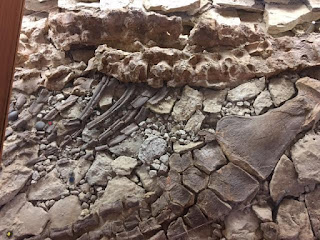Click on the above "Free Printable Downloads" button to be able to print pictures to color.
Pahasapsaurus haasi
Pahasapsaurus was a type of marine reptile called a plesiosaur. They were fast swimmers that had very streamlined bodies. Some had very long necks. This species had a shorter neck. If a Plesiosaur has a short thick neck...or pretty much no neck it is called a Pliosaur. THIS animal had a longer neck than a Pliosaur so they are called long necked Plesiosaurs. They lived at the same time as dinosaurs, but they were NOT dinosaurs. They were marine reptiles. They had eyeballs the size of baseballs and could see in the darkness of deeper water...but this is darkness like a shallow sea has a few hundred feet down, not the deep blue ocean.
They ate squid, fish, and a curly shelled type of animal called an ammonite. This drawing shows a Cretaceous period scene of the above mentioned animals. This animal was found in South Dakota in 1934 by a paleontologist named Charles C. Haas and his son. They were looking for shark teeth. This marine reptile gets its name from the nearby Black Hills. "Paha Sapa" is the name for the Black Hills of South Dakota to the Lakota Sioux Native American Tribe. Of course the species name is haasi, named after Charles Haas who discovered the fossilized skeleton.
You need to know that during the Cretaceous Period, right after the Jurassic Period, much of the mid-west of North America was covered by a shallow sea. Because of this many marine reptile skeletons and teeth are found in the mid-west of the United States and Canada. . . even though that part of the continent is now hundreds of miles from the nearest ocean.
The below photos are from the Adam's Museum in Deadwood South Dakota. You have to go into the basement floor to see this amazing site.
Pahsapasaurus Head
Pahasapasaurus neck
Pahasapasaurus front flipper, spine and ribs
Robin in front of the display case with skeleton of Pahasapasaurus
The entire fossilized skeleton is in this case.
NOTE: All drawings and content on this blog is Copyright 2017 or earlier by Robin A. Lyman.





No comments:
Post a Comment